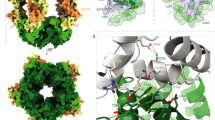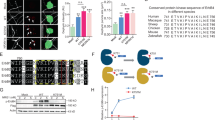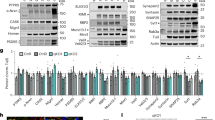Abstract
The establishment of synaptic connections requires precise alignment of pre- and postsynaptic terminals. The glial cell line–derived neurotrophic factor (GDNF) receptor GFRα1 is enriched at pre- and postsynaptic compartments in hippocampal neurons, suggesting that it has a function in synapse formation. GDNF triggered trans-homophilic binding between GFRα1 molecules and cell adhesion between GFRα1-expressing cells. This represents the first example of a cell-cell interaction being mediated by a ligand-induced cell adhesion molecule (LICAM). In the presence of GDNF, ectopic GFRα1 induced localized presynaptic differentiation in hippocampal neurons, as visualized by clustering of vesicular proteins and neurotransmitter transporters, and by activity-dependent vesicle recycling. Presynaptic differentiation induced by GDNF was markedly reduced in neurons lacking GFRα1. Gdnf mutant mice showed reduced synaptic localization of presynaptic proteins and a marked decrease in the density of presynaptic puncta, indicating a role for GDNF signaling in hippocampal synaptogenesis in vivo. We propose that GFRα1 functions as a LICAM to establish precise synaptic contacts and induce presynaptic differentiation.
This is a preview of subscription content, access via your institution
Access options
Subscribe to this journal
Receive 12 print issues and online access
$209.00 per year
only $17.42 per issue
Buy this article
- Purchase on Springer Link
- Instant access to full article PDF
Prices may be subject to local taxes which are calculated during checkout






Similar content being viewed by others
References
Scheiffele, P. Cell-cell signaling during synapse formation in the CNS. Annu. Rev. Neurosci. 26, 485–508 (2003).
Yamagata, M., Sanes, J.R. & Weiner, J.A. Synaptic adhesion molecules. Curr. Opin. Cell Biol. 15, 621–632 (2003).
Scheiffele, P., Fan, J., Choih, J., Fetter, R. & Serafini, T. Neuroligin expressed in non-neuronal cells triggers presynaptic development in contacting axons. Cell 101, 657–669 (2000).
Dean, C. et al. Neurexin mediates the assembly of presynaptic terminals. Nat. Neurosci. 6, 708–716 (2003).
Biederer, T. et al. SynCAM, a synaptic adhesion molecule that drives synapse assembly. Science 297, 1525–1531 (2002).
Hall, A.C., Lucas, F.R. & Salinas, P.C. Axonal remodeling and synaptic differentiation in the cerebellum is regulated by WNT-7a signaling. Cell 100, 525–535 (2000).
Umemori, H., Linhoff, M.W., Ornitz, D.M. & Sanes, J.R. FGF22 and its close relatives are presynaptic organizing molecules in the mammalian brain. Cell 118, 257–270 (2004).
Christopherson, K.S. et al. Thrombospondins are astrocyte-secreted proteins that promote CNS synaptogenesis. Cell 120, 421–433 (2005).
Vicario-Abejon, C., Owens, D., McKay, R. & Segal, M. Role of neurotrophins in central synapse formation and stabilization. Nat. Rev. Neurosci. 3, 965–974 (2002).
Cohen-Cory, S. The developing synapse: construction and modulation of synaptic structures and circuits. Science 298, 770–776 (2002).
Alsina, B., Vu, T. & Cohen-Cory, S. Visualizing synapse formation in arborizing optic axons in vivo: dynamics and modulation by BDNF. Nat. Neurosci. 4, 1093–1101 (2001).
Cohen-Cory, S. & Fraser, S.E. Effects of brain-derived neurotrophic factor on optic axon branching and remodelling in vivo. Nature 378, 192–196 (1995).
McAllister, A.K., Katz, L.C. & Lo, D.C. Opposing roles for endogenous BDNF and NT-3 in regulating cortical dendritic growth. Neuron 18, 767–778 (1997).
Yamada, M.K. et al. Brain-derived neurotrophic factor promotes the maturation of GABAergic mechanisms in cultured hippocampal neurons. J. Neurosci. 22, 7580–7585 (2002).
Poo, M.M. Neurotrophins as synaptic modulators. Nat. Rev. Neurosci. 2, 24–32 (2001).
Airaksinen, M.S. & Saarma, M. The GDNF family: signalling, biological functions and therapeutic value. Nat. Rev. Neurosci. 3, 383–394 (2002).
Trupp, M. et al. Functional receptor for glial cell line–derived neurotrophic factor encoded by the c-ret proto-oncogene product. Nature 381, 785–789 (1996).
Durbec, P. et al. Glial cell line–derived neurotrophic factor signalling through the Ret receptor tyrosine kinase. Nature 381, 789–792 (1996).
Paratcha, G., Ledda, F. & Ibáñez, C.F. The neural cell adhesion molecule NCAM is an alternative signaling receptor for GDNF family ligands. Cell 113, 867–879 (2003).
Sariola, H. & Saarma, M. Novel functions and signalling pathways for GDNF. J. Cell Sci. 116, 3855–3862 (2003).
Ledda, F., Paratcha, G. & Ibáñez, C.F. Target-derived GFRα1 as an attractive guidance signal for developing sensory and sympathetic axons via activation of Cdk5. Neuron 36, 387–401 (2002).
Paratcha, G. et al. Released GFRα1 potentiates downstream signaling, neuronal survival, and differentiation via a novel mechanism of recruitment of c-Ret to lipid rafts. Neuron 29, 171–184 (2001).
Bourque, M.J. & Trudeau, L.E. GDNF enhances the synaptic efficacy of dopaminergic neurons in culture. Eur. J. Neurosci. 12, 3172–3180 (2000).
Wang, C.Y. et al. Regulation of neuromuscular synapse development by glial cell line–derived neurotrophic factor and neurturin. J. Biol. Chem. 277, 10614–10625 (2002).
Scott, R.P. & Ibáñez, C.F. Determinants of ligand binding specificity in the glial cell line–derived neurotrophic factor family receptor alphas. J. Biol. Chem. 276, 1450–1458 (2001).
Eigenbrot, C. & Gerber, N. X-ray structure of glial cell–derived neurotrophic factor at 1.9 angstrom resolution and implications for receptor binding. Nat. Struct. Biol. 4, 435–438 (1997).
Jing, S. et al. GDNF-induced activation of the ret protein tyrosine kinase is mediated by GDNFR-α, a novel receptor for GDNF. Cell 85, 1113–1124 (1996).
Wiesmann, C., Ultsch, M.H., Bass, S.H. & de Vos, A.M. Crystal structure of nerve growth factor in complex with the ligand-binding domain of the TrkA receptor. Nature 401, 184–188 (1999).
Leppanen, V.M. et al. The structure of GFRα1 domain 3 reveals new insights into GDNF binding and RET activation. EMBO J. 23, 1452–1462 (2004).
Trupp, M., Raynoschek, C., Belluardo, N. & Ibáñez, C.F. Multiple GPI-anchored receptors control GDNF-dependent and independent activation of the c-Ret receptor tyrosine kinase. Mol. Cell. Neurosci. 11, 47–63 (1998).
Trupp, M., Belluardo, N., Funakoshi, H. & Ibáñez, C.F. Complementary and overlapping expression of glial cell line–derived neurotrophic factor (GDNF), c-ret proto-oncogene, and gdnf receptor-α indicates multiple mechanisms of trophic actions in the adult rat CNS. J. Neurosci. 17, 3554–3567 (1997).
Pozas, E. & Ibáñez, C.F. GDNF and GFRα1 promote differentiation and tangential migration of cortical GABAergic neurons. Neuron 45, 701–713 (2005).
Ziv, N.E. & Garner, C.C. Cellular and molecular mechanisms of presynaptic assembly. Nat. Rev. Neurosci. 5, 385–399 (2004).
Pina Serra, M., Quartu, M., Ambu, R., Follesa, P. & Del Fiacco, M. Immunohistochemical localization of GDNF in the human hippocampal formation from prenatal life to adulthood. Brain Res. 928, 138–146 (2002).
Miyazaki, H., Nagashima, K., Okuma, Y. & Nomura, Y. Expression of glial cell line–derived neurotrophic factor induced by transient forebrain ischemia in rats. Brain Res. 922, 165–172 (2001).
Gerlai, R. et al. Impaired water maze learning performance without altered dopaminergic function in mice heterozygous for the GDNF mutation. Eur. J. Neurosci. 14, 1153–1163 (2001).
Voikar, V., Rossi, J., Rauvala, H. & Airaksinen, M.S. Impaired behavioural flexibility and memory in mice lacking GDNF family receptor α2. Eur. J. Neurosci. 20, 308–312 (2004).
Cremer, H. et al. Long-term but not short-term plasticity at mossy fiber synapses is impaired in neural cell adhesion molecule–deficient mice. Proc. Natl. Acad. Sci. USA 95, 13242–13247 (1998).
Dityatev, A., Dityateva, G. & Schachner, M. Synaptic strength as a function of post- versus presynaptic expression of the neural cell adhesion molecule NCAM. Neuron 26, 207–217 (2000).
Polo-Parada, L., Bose, C.M. & Landmesser, L.T. Alterations in transmission, vesicle dynamics, and transmitter release machinery at NCAM-deficient neuromuscular junctions. Neuron 32, 815–828 (2001).
Sytnyk, V., Leshchyns'ka, I., Nikonenko, A.G. & Schachner, M. NCAM promotes assembly and activity-dependent remodeling of the postsynaptic signaling complex. J. Cell Biol. 174, 1071–1085 (2006).
Ginsberg, M.H., Partridge, A. & Shattil, S.J. Integrin regulation. Curr. Opin. Cell Biol. 17, 509–516 (2005).
Cammarota, M. et al. Cyclic AMP-responsive element binding protein in brain mitochondria. J. Neurochem. 72, 2272–2277 (1999).
Matteoli, M., Takei, K., Perin, M.S., Sudhof, T.C. & De Camilli, P. Exo-endocytotic recycling of synaptic vesicles in developing processes of cultured hippocampal neurons. J. Cell Biol. 117, 849–861 (1992).
Maximov, A. & Bezprozvanny, I. Synaptic targeting of N-type calcium channels in hippocampal neurons. J. Neurosci. 22, 6939–6952 (2002).
Acknowledgements
We thank D. Sjöstrand for western blot of NCAM and GFRα1 in COS cells, A. Moliner for help with Jurkat cell cultures, R. Scott for deletion constructs of GFRα1, T. Harkany, E. Restrepo, B. Stevens and B. Barres for experimental advice and W. Friedman, M. Fainzilber, A. Canty and L. Reichardt for comments and suggestions. This work was funded by grants from the Swedish Foundation for Strategic Research, the Swedish Research Council (33X-10908-10A) and the European Commission (QLG3-CT-2002-01000). F.L. was partially supported by the David och Astrid Hageléns Foundation, the Swedish Research Council (33P-15416-01A) and the Foundation for Geriatric Disease and Karolinska Institute, and G.P. by the Swedish Research Council (33PS-14809-01A). T.S.-G. was partially supported by the European Union NeuroNE network (LSHM-CT-2004-512039).
Author information
Authors and Affiliations
Corresponding authors
Ethics declarations
Competing interests
The authors declare no competing financial interests.
Supplementary information
Supplementary Fig. 1
Expression of GDNF receptors in hippocampus. (PDF 114 kb)
Supplementary Fig. 2
Comparison between the adhesive activities of GFRα1 and NCAM. (PDF 611 kb)
Supplementary Fig. 3
Lack of heterophilic interactions in trans between GFRα1 and NCAM. (PDF 685 kb)
Supplementary Fig. 4
Trans-homophilic interactions between GFRα1 molecules require an intact GDNF binding domain. (PDF 615 kb)
Supplementary Fig. 5
GDNF regulates the aggregation, but not the expression, of vesicle-associated pre-synaptic proteins in hippocampal neurons. (PDF 701 kb)
Supplementary Fig. 6
Localized induction of presynaptic differentiation by immobilized GFRα proteins in the presence of GDNF ligands. (PDF 697 kb)
Supplementary Fig. 7
GDNF binding to NCAM in hippocampal synaptosomes and Gdnf mRNA expression in P15 Gdnf+/− hippocampus. (PDF 84 kb)
Supplementary Fig. 8
Synaptophysin content in synapses of P15 and 6-week-old Gdnf+/− mice. (PDF 583 kb)
Supplementary Fig. 9
Schematic of synapse formation by ligand-induced cell adhesion. (PDF 524 kb)
Supplementary Fig. 10
Controls for Jurkat cell adhesion experiments. (PDF 610 kb)
Rights and permissions
About this article
Cite this article
Ledda, F., Paratcha, G., Sandoval-Guzmán, T. et al. GDNF and GFRα1 promote formation of neuronal synapses by ligand-induced cell adhesion. Nat Neurosci 10, 293–300 (2007). https://doi.org/10.1038/nn1855
Received:
Accepted:
Published:
Issue Date:
DOI: https://doi.org/10.1038/nn1855
This article is cited by
-
Effects of gestational inflammation on age-related cognitive decline and hippocampal Gdnf-GFRα1 levels in F1 and F2 generations of CD-1 Mice
BMC Neuroscience (2023)
-
Therapeutic potential of neurotrophic factors in Alzheimer’s Disease
Molecular Biology Reports (2022)
-
Glial Cell Line-Derived Neurotrophic Factor and Focal Ischemic Stroke
Neurochemical Research (2021)
-
AMPA Receptor Expression Requirement During Long-Term Memory Retrieval and Its Association with mTORC1 Signaling
Molecular Neurobiology (2021)
-
RET-independent signaling by GDNF ligands and GFRα receptors
Cell and Tissue Research (2020)



